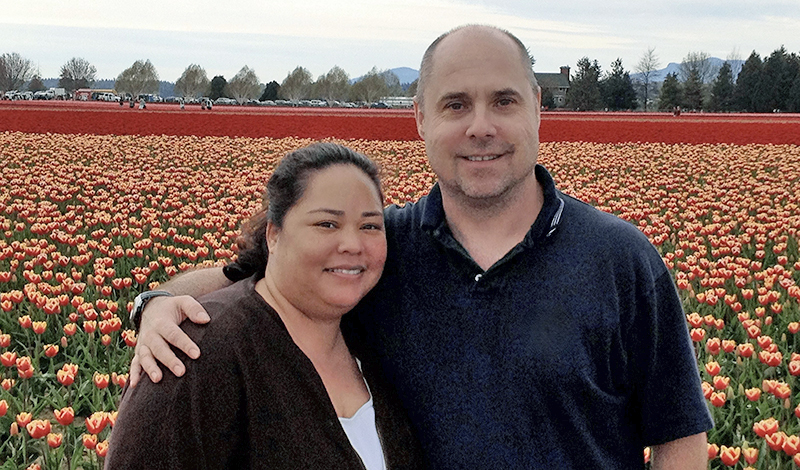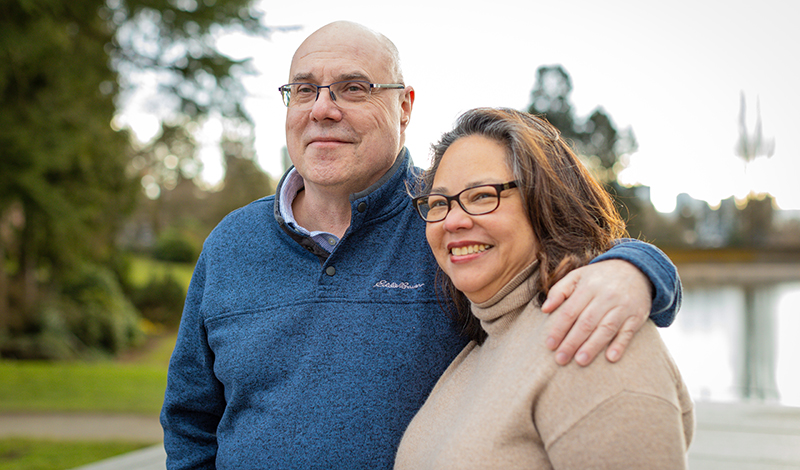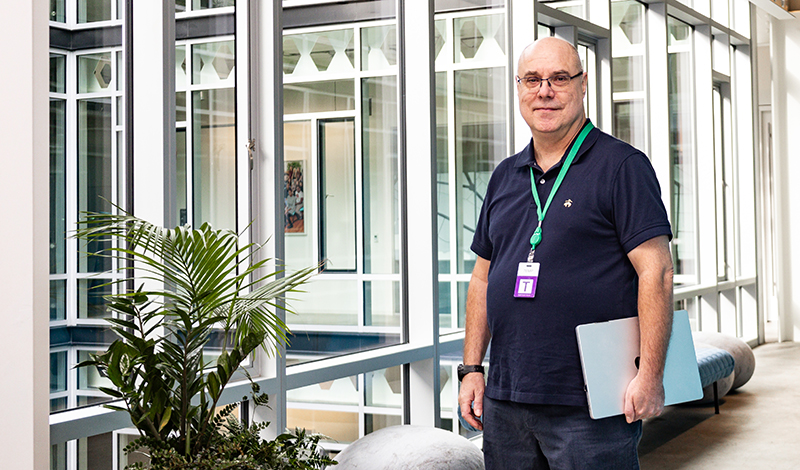Living Buddhism: Thank you for speaking with us today, Les. You’ve been practicing Buddhism now for 40 years. What did you chant for at the outset of your practice?
Les Hayward: At the outset? Honestly? Money. May not be the most inspired prayer, but that’s what I wanted. Or at least, what
I thought I wanted. On a deeper level, what I truly wanted was what I hoped money would buy: freedom from desperation, confidence in myself.
Call it what you want: poverty, death, illness, hunger—the misfortunes that dogged my youth were, to my mind, different names for bad luck. Bad luck was what I had, plain and simple, and I could not shake the feeling, the deep suspicion, that it would follow me to the grave.
We understand you lost your mother when you were young.
Les: I was with her when it happened, waiting in line at the bank, thinking about butter noodles.
Butter noodles.
Les: A cheap, starchy staple of the projects where we lived. Going to the bank meant cashing a welfare check, and cashing that check meant butter noodles on the table.
You’re chuckling now, but it sounds dire.
Les: Yes—oh, it was. Poverty dogged our home and neighborhood. Illness, too. My mother had a thyroid condition that caused huge fluctuations in blood pressure. That day at the bank, her blood pressure spiked, triggering a stroke that brought her to the ground. She was taken to the hospital, and I was taken home where I sat on the edge of my bed, waiting in fear. When the news did come, fear, as well as every other feeling drained from my limbs. A stillness spread from my gut, numbing my body and mind.
Where did you go?
Les: Onto the streets of Seattle. After a brief stay with my aunt and uncle, I ran away and was homeless until the age of 16, when the mother of a friend I’d made at the local rec center became keenly interested in my life. As she peppered me with questions, my only thought was, What’s it to you? If she was put off by one-word responses, she didn’t show it. She adopted me, and it was in her house that I encountered Nichiren Buddhism.
Eventually, you gave it a go. Why?
Les: I met people, particularly young people who were applying Buddhist practice to tangibly advance toward their dreams and began to sense that it might prove relevant to my own. I tried it out and got all kinds of “conspicuous benefits”—a job, a little confidence, a girlfriend.
But there was something missing.
Les: Yes. At the dead center of my life, I felt that something was missing. All around me, I saw friends in faith living with joyful purpose. I understood my situation was distinct and tried to not compare myself too harshly, but if understanding this was a small comfort, it also prevented me from believing that I could live in the way my peers were living—with deep joy and confidence. If I considered my situation distinctly difficult, I also considered myself distinctly exempt from the possibility of happiness. I saw clearly that this Buddhism worked—for others. If certain ideas didn’t resonate—that my life possessed infinite potential, for instance—I simply assumed that they didn’t concern me. So much encouragement from Ikeda Sensei, wisdom from Nichiren Daishonin, praise from friends and seniors in faith, ran up against a high wall I’d raised around my heart and retreated behind.
When did things begin to change?
Les: On a fundamental level, it was, for me, the early ’90s, a time of profound upheaval in the history of our movement, when the Soka Gakkai gained independence from the Nichiren Shoshu priesthood following the priesthood’s complete spiritual and moral degeneration.[1]
Sensei came to the U.S. at this time to emphasize the basics of Buddhism. Human revolution, a term I’d heard without it ever quite registering, was placed squarely at the center of my understanding of faith.
In The Record of the Orally Transmitted Teachings, Nichiren Daishonin says, “[O]rdinary people are identical with the highest level of being [i.e., Buddhahood]” (p. 22), and “the Buddha of the Latter Day of the Law is an ordinary mortal” (p. 157).
The priesthood’s attacks on the very heart of faith, Sensei said, presented a rare opportunity to radically transform our karma. Battling against the fundamental evils that deny the existence of the Buddha nature in all people is the sure path to transforming negative karma in our own lives.
What did that look like, practically speaking?
Les: Fierce daimoku and courageous dialogue. Discussing the truth of our movement and my mentor with those considering quitting their faith, I was disparaged, threatened, accused and dismissed. Facing these reactions without losing my cool, I confronted head-on my own fundamental ignorance—the doubts, fears and disparagements operating within the depths of my life. Explaining to one person after another that they themselves could bring forth the Buddha nature, I challenged directly my own profound doubts that I could, too. Indeed, such conversations themselves required me to do so.
It sounds like these dialogues shifted something deep in your heart.
Les: They did. And I should say, my heart was not an easy thing to move. A big, boulder-like thing, budging it called for more than your usual shovel and stick. Through these dialogues, my heart began to open to Sensei’s guidance as something written with me in mind.
What was Sensei saying that was so hard to hear?
Les: That my life and others’ lives were invaluable. Even after years of Buddhist practice, I struggled with a profound sense that my life was not valuable, and it showed up in everything I did—in work, in friendship, in partnership. I struggled to open myself to others and to build lasting connections. I was afraid of what I stood to lose if I opened my heart to another person.

When did you do this, really—open your heart to another?
Les: It was at the turn of the century, in my 30s. I remember sitting down in front of the Gohonzon and chanting, no holds barred, praying—no, demanding—to understand what it meant that my life itself is Nam-myoho-renge-kyo. I went on a daimoku campaign, chanting abundant daimoku over the course of a year with that single-minded prayer. What happened during that year was that I became more and more receptive to Sensei’s guidance, allowing myself to learn and to seek, to ask, What is it that Sensei is saying to me?
As I chanted in this way, I began to accept what Sensei had been urging me to accept all along: faith in the goodness within my life. Faith in the Buddha nature inherent in all living beings. From such an expanded state of life, I began an unflinching examination of age-old fears—of poverty, homelessness, illness and death. “Faith is to fear nothing,”[2] Sensei once wrote in a poem to the youth of America. Slowly, I began to grasp what this meant, not intellectually but with my heart.
Something I’d clung to fiercely, fearfully, was money—the little that I had. A good job was what I wanted, because a good job meant a big check and a big check meant safety. But as I chanted, I began to open up to a feeling I’d never truly felt: That I was safe, that I was valuable, indispensable, just as I was.
As May 2003 approached, I had the realization that I’d never made a joyful financial contribution to the SGI. I’d give a little, sparingly, anxiously. It was time, I felt, to challenge this fear, to uproot it from my life.
What came of this?
Les: A neighbor. He knocked while I was chanting, several times before I heard him over my vigorous daimoku. He wanted to know more about the chant, with which he was familiar; a co-worker had mentioned it to him. As it turns out, I knew her, too; I’d seen her supporting activities behind the scenes at the Seattle Buddhist Center. At my neighbor’s suggestion, the three of us began to meet to talk about Buddhism. One day, as we were leaving, my neighbor said: “You know what. I think you two should go on a date.” I laughed and she laughed, but then she shrugged and then I shrugged, and she said, “Why not?” Now, Mia’s my wife.

You were still struggling financially when you met?
Les: Yes, and she as well. Actually, we were very hesitant to marry for this reason. We chanted a lot, though, and decided to win together over our fears. Just as fear had once colored every area of my life, confidence was now repaid with confidence. I landed a tech job and was paid to receive the training that qualified me for a promotion and a doubling of pay.
In 2008, my wife and I married. Shortly after, the global stock market crashed and my company laid off a third of its employees. I, however, was kept on and received not one but two raises over the next two years.
Incredible. We heard you had a recent victory. Can you tell us about it?
Les: Well, in 2016, I was feeling stagnant. It was at this time that I reread Nichiren’s letter “The Gift of Rice” and realized that my life had slid back into a state of chronic, low-grade fear characterized by a lack of appreciation.
Nichiren says, “Ordinary people keep in mind the words ‘earnest resolve’ and thereby become Buddhas.”[3] In other words, taking action with sincere dedication is the direct path to attaining Buddhahood.
My wife and I chanted, discussed and decided to challenge ourselves, out of a sense of appreciation, to increase our May Contribution annually.
In 2022, we set a high goal, something that required me to expand my prayer and steel my resolve. As May drew near, we were at only a third of our goal, and I began to have doubts. But at the end of February, I received a large bonus that fully covered our contribution. Then in July, I was offered a new role. Asked my salary expectation, I named a high figure, based on a deeper respect for my own life. Part of me seriously doubted that they would accept the figure, but to my surprise, they did. Moreover, the benefits offered were incredible. Both my wife and I have a chronic health condition that requires regular treatment. We’re too active in the SGI to let it slow us down, and we don’t worry about it too much. But the treatment is expensive. In my new role, however, I was informed that most of our medical expenses would be covered. Truly, I feel this is protection from the Gohonzon.
What do you chant about these days?
Les: These days, my prayers are largely for the youth of Seattle. Many of them remind me of myself at their age, stubbornly withdrawn, wary of kindness, fearful that their actions will fail to effect meaningful change. But I face the Gohonzon with earnest resolve. I chant to do the human revolution necessary to reach the hearts of these youth. And I strive to live as a disciple of Sensei, a life of faith, which is to believe in myself and fear nothing.
From the May 2024 Living Buddhism
References
- On November 28, 1990, the Nichiren Shoshu priesthood excommunicated Ikeda Sensei and the Soka Gakkai’s 10 million members in a desperate attempt to seize control of the organization and its resources. In the years leading up to this moment, one unprecedented in the history of Buddhism, Nichiren Shoshu began emphasizing the superiority of the priesthood over the laity and its role as an essential catalyst for attaining enlightenment, which are teachings not found in Nichiren Daishonin’s writings. The vast majority of members chose to continue practicing with the SGI, under Sensei’s leadership. The SGI’s departure from the feudalistic, authoritarian priesthood allowed Nichiren Buddhism to blossom as a world religion, expanding its membership from 115 to 192 countries. Today, SGI members around the world celebrate November 28 as our Day of Spiritual Independence. ↩︎
- The Sun of Youth, p. 72. ↩︎
- The Writings of Nichiren Daishonin, vol. 1, p. 1125. ↩︎
You are reading {{ meterCount }} of {{ meterMax }} free premium articles

